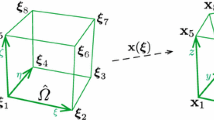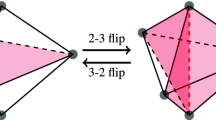Abstract
We are concerned with the task of constructing an optimal higher-order finite element mesh under a constraint on the total number of degrees of freedom. The motivation for this work is to obtain a truly optimal higher-order finite element mesh that can be used to compare the quality of automatic adaptive algorithms. Minimized is the approximation error in a global norm. Optimization variables include the number of elements, positions of nodes, and polynomial degrees of elements. Optimization methods and software that we use are described, and numerical results are presented.










Similar content being viewed by others
References
Babuška I, Strouboulis T (2001) The finite element methods and its reliability. Clarendon Press, Oxford
Babuška I, Strouboulis T, Copps K (1997) \(hp\) optimization of finite element approximations: analysis of the optimal mesh sequences in one dimension. Comput Methods Appl Mech Eng 150(1–4):89–108
Demkowicz LF (2007) Computing with \(hp\)-adaptive finite elements. Vol. 1: One- and two-dimensional elliptic and Maxwell problems. With CD-ROM. Applied Mathematics and Nonlinear Science Series. Chapman & Hall/CRC, Boca Raton
Demkowicz LF, Kurtz J, Pardo D, Paszyński M, Rachowicz W, Zdunek A (2008) Computing with \(hp\)-adaptive finite elements. Vol. II: Frontiers: three-dimensional elliptic and Maxwell problems with applications. Applied Mathematics and Nonlinear Science Series. Chapman & Hall/CRC, Boca Raton
Dörfler W, Heuveline V (2007) Convergence of an adaptive \(hp\) finite element strategy in one space dimension. Appl Numer Math 57(10):1108–1124
Eibner T, Melenk J (2007) An adaptive strategy for \(hp\)-FEM based on testing for analyticity. Comput Mech 39(5):575–595
Gui W, Babuška I (1986) The \(h\), \(p\) and \(h\)-\(p\) versions of the finite element method in 1 dimension. III. The adaptive \(h\)-\(p\) version. Numer Math 49:659–683
Schwab C (1998) \(p\)- and \(hp\)-finite element methods: theory and applications in solid and fluid mechanics. Numerical Mathematics and Scientific Computation. Clarendon Press, Oxford
Šolín P, Segeth K, Doležel I (2004) Higher-order finite element methods. Studies in Advanced Mathematics. Chapman & Hall/CRC, Boca Raton
Wihler TP (2011) An \(hp\)-adaptive strategy based on continuous Sobolev embeddings. J Comput Appl Math 235(8):2731–2739
Acknowledgments
The first author is grateful to Dr. Richard (Dick) Haas for many fruitful discussions.
Author information
Authors and Affiliations
Corresponding author
Additional information
The research of the first author was supported by Czech Science Foundation Grant No. P105/10/1682. The research of the second author was partly supported by Czech Science Foundation Grant No. P105/10/1682.
Rights and permissions
About this article
Cite this article
Chleboun, J., Solin, P. On optimal node and polynomial degree distribution in one-dimensional \(hp\)-FEM. Computing 95 (Suppl 1), 75–88 (2013). https://doi.org/10.1007/s00607-012-0232-x
Received:
Accepted:
Published:
Issue Date:
DOI: https://doi.org/10.1007/s00607-012-0232-x




